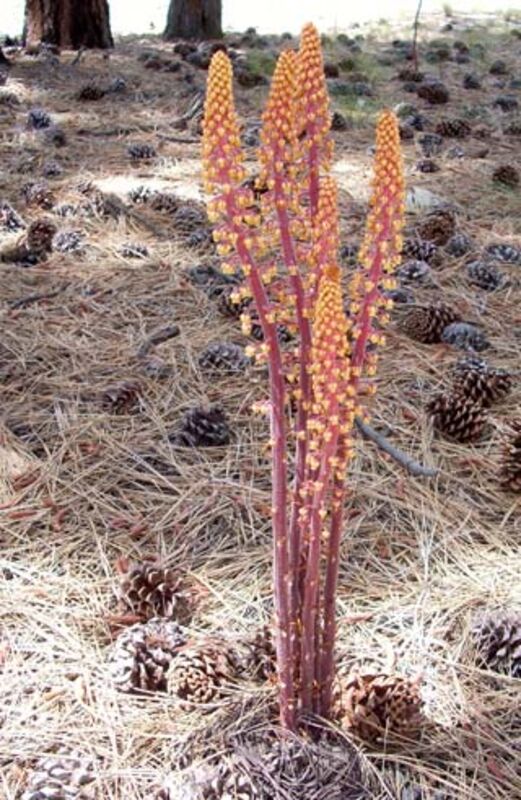Pinedrop: Difference between revisions
No edit summary |
No edit summary |
||
| Line 1: | Line 1: | ||
=='''Classification'''== | =='''Classification'''== | ||
Kingdom: '' | Kingdom: ''Plantae'' | ||
Phylum: ''Magnoliophyta'' | Phylum: ''Magnoliophyta'' | ||
| Line 10: | Line 10: | ||
=='''Introduction'''== | =='''Introduction'''== | ||
Pterospora andromedea, commonly known as Pinedrops, is a parasitic plant of the | Pterospora andromedea, commonly known as Pinedrops, is a parasitic plant of the Heath family. This plant relies on mycoheterotrophy, the plant nutrition tactic that involves getting its carbon and other nutrients from fungi rather than photosynthesis [1]. Pinedrops are easily identified by their red stalk with bell-shaped flowers that hang upside down. Stems in the eastern United States tend to reach a maximum height of 50cm, while some species on the west coast reach 100cm.[4] | ||
=='''Range & Habitat'''== | =='''Range & Habitat'''== | ||
Pinedrops are native to coniferous forests of North America, and commonly | Pinedrops are native to coniferous forests of North America, and commonly grow from the [[soil]] below pine trees. Populations can be found in the United States, Canada, and Mexico, though it is most commonly found in mountainous regions such as the Northern Appalachians or the Rockies. Pinedrop grows well in acidic, well-drained, nutrient-poor soils [3]. They also need coniferous forests with ectomycorrhizal growth, which they rely on for nutrients. Pinedrops are more likely to be found in older forests with less disturbance because these conditions promote the growth of the fungi systems they prey on. In the eastern United States, Pinedrops are most commonly found in white pine forests[4]. | ||
=='''Mycroheterotrophy and Role in Soil Ecology'''== | =='''Mycroheterotrophy and Role in Soil Ecology'''== | ||
The mutualistic relationship between pines and mycorrhizal fungi allows Pinedrops to survive. The trees provide the fungi with the glucose created through photosynthesis | The mutualistic relationship between pines and mycorrhizal fungi allows Pinedrops to survive. The trees provide the fungi with the glucose created through photosynthesis. In exchange, the fungus provides nutrients the tree is not capable of retrieving on its own, like nitrogen. Mycorrhizal fungi can also make it easier for the tree to collect water [2]. Pinedrops are parasites and take advantage of this mutualism. They take the nutrients glucose and water from the fungi while it is exchanging with the tree. These specific relationships and circumstances make the Pinedrop uncommon. They can also be used as an indicator to tell if a forest is thriving and when there are changes from effects like climate change[5]. | ||
==Refrences== | ==Refrences== | ||
| Line 24: | Line 24: | ||
[3]Woodland Pinedrops. (n.d.). . https://www.fs.usda.gov/wildflowers/plant-of-the-week/pterospora_andromedea.shtml. | [3]Woodland Pinedrops. (n.d.). . https://www.fs.usda.gov/wildflowers/plant-of-the-week/pterospora_andromedea.shtml. | ||
[4]Hazard, C., E. A. Lilleskov, and T. R. Horton. 2012. Is rarity of pinedrops (Pterospora andromedea) in eastern North America linked to rarity of its unique fungal symbiont? Mycorrhiza 22:393–402. https://link.springer.com/article/10.1007/s00572-011-0414-y | |||
[5]Grubisha, L. C., B. A. Nelson, N. J. Dowie, S. L. Miller, and M. R. Klooster. 2014. Characterization of microsatellite markers for pinedrops, Pterospora andromedea (Ericaceae), from Illumina MiSeq sequencing. Applications in Plant Sciences 2:1400072.https://bsapubs.onlinelibrary.wiley.com/doi/full/10.3732/apps.1400072 | |||
Revision as of 11:30, 29 April 2025
Classification
Kingdom: Plantae
Phylum: Magnoliophyta
Class: Magnoliopsida

Introduction
Pterospora andromedea, commonly known as Pinedrops, is a parasitic plant of the Heath family. This plant relies on mycoheterotrophy, the plant nutrition tactic that involves getting its carbon and other nutrients from fungi rather than photosynthesis [1]. Pinedrops are easily identified by their red stalk with bell-shaped flowers that hang upside down. Stems in the eastern United States tend to reach a maximum height of 50cm, while some species on the west coast reach 100cm.[4]
Range & Habitat
Pinedrops are native to coniferous forests of North America, and commonly grow from the soil below pine trees. Populations can be found in the United States, Canada, and Mexico, though it is most commonly found in mountainous regions such as the Northern Appalachians or the Rockies. Pinedrop grows well in acidic, well-drained, nutrient-poor soils [3]. They also need coniferous forests with ectomycorrhizal growth, which they rely on for nutrients. Pinedrops are more likely to be found in older forests with less disturbance because these conditions promote the growth of the fungi systems they prey on. In the eastern United States, Pinedrops are most commonly found in white pine forests[4].
Mycroheterotrophy and Role in Soil Ecology
The mutualistic relationship between pines and mycorrhizal fungi allows Pinedrops to survive. The trees provide the fungi with the glucose created through photosynthesis. In exchange, the fungus provides nutrients the tree is not capable of retrieving on its own, like nitrogen. Mycorrhizal fungi can also make it easier for the tree to collect water [2]. Pinedrops are parasites and take advantage of this mutualism. They take the nutrients glucose and water from the fungi while it is exchanging with the tree. These specific relationships and circumstances make the Pinedrop uncommon. They can also be used as an indicator to tell if a forest is thriving and when there are changes from effects like climate change[5].
Refrences
[1]Mycoheterotrophy - an overview | ScienceDirect Topics. (n.d.). . https://www.sciencedirect.com/topics/agricultural-and-biological-sciences/mycoheterotrophy.
[2]Mycorrhizal fungi / RHS. (n.d.). . https://www.rhs.org.uk/biodiversity/mycorrhizal-fungi.
[3]Woodland Pinedrops. (n.d.). . https://www.fs.usda.gov/wildflowers/plant-of-the-week/pterospora_andromedea.shtml.
[4]Hazard, C., E. A. Lilleskov, and T. R. Horton. 2012. Is rarity of pinedrops (Pterospora andromedea) in eastern North America linked to rarity of its unique fungal symbiont? Mycorrhiza 22:393–402. https://link.springer.com/article/10.1007/s00572-011-0414-y
[5]Grubisha, L. C., B. A. Nelson, N. J. Dowie, S. L. Miller, and M. R. Klooster. 2014. Characterization of microsatellite markers for pinedrops, Pterospora andromedea (Ericaceae), from Illumina MiSeq sequencing. Applications in Plant Sciences 2:1400072.https://bsapubs.onlinelibrary.wiley.com/doi/full/10.3732/apps.1400072